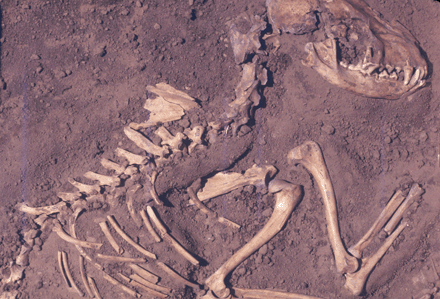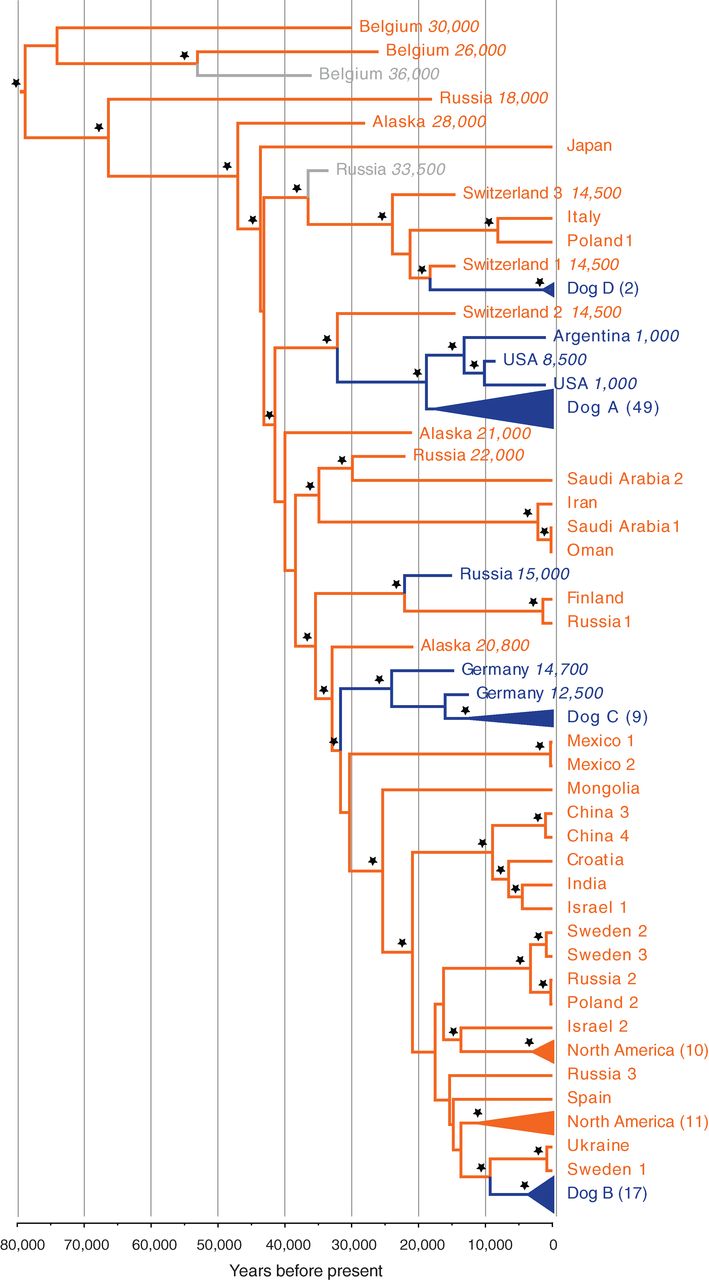Where do dogs come from?

This web page was produced as an assignment for an undergraduate course at Davidson College.
Assignment #1: published genomics project
Where do dogs come from?

A 8500-year-old dog in Illinois. Credit: Del Baston, Center for American Archaeology via Science Magazine.
Phylogentic tree of modern and ancient dogs (blue) and wolves (orange). Country names and years indicate the origin and approximate age of the ancient specimens. Numbers in parenthesis indicate number of sequences. Credit: Thalmann et al., 2013 via Science Magazine. Permission pending. Genomics Page Email Questions or Comments: jozhou@davidson.edu © Copyright 2016 Department of Biology, Davidson College,
Davidson, NC 28035
Background: Dogs have been men's best friend for a long time. While the origin of humans has been uncovered in the midst of the Genomics Revolution, the origins of dogs remain controversial. It is widely accepted that domestic dogs evolved from wolves, but there exist several theories of the temporal and geographic origins of modern dogs. One group (Axelsson et al., 2012) suggested that dogs were domesticated around 10,000 years ago during the Agricultural Revolution. Another group (Wang et al., 2012) suggested that dogs and wolves split 32,000 years ago in East Asia.
What was the research project? A new study (Thalmann et al., 2013), published in Science in November 2013, extracted and analyzed the mitochondrial genomes of modern dogs and ancient wolf-like animals. Based on the genomic analyses, the authors concluded that domestic dogs evolved from a group of now-extinct gray wolves that came into contact with European hunter-gathers sometime between 18,800 and 32,100 years ago. The results provide a picture of where, when and how wild wolves became man's best friend.
Were they testing a hypothesis or doing discovery science? There exist many different theories of the origins of dogs, depending on the methods and the sequence data used in the studies. The authors did not propose a hypothesis, they hoped to confirm or contradict exiting theories by sequencing and analyzing a different set of genome data, particularly data from ancient fossil canids mainly from Europe. Therefore, it is an example of discovery-driven science.
What genomic technology was used in the project? Researchers extracted complete and partial mitochondrial DNA by performing DNA capture. Using high-throughput sequencing, the researchers sequenced the mitochondrial DNA from 18 fossils of ancient wolf-dogs from Europe. Then, they compared it with complete mitochondrial genome from 49 wolves, 77 dogs of many breeds, and 4 coyotes in terms of sequence length, sample age and patterns typical of ancient DNA. Based on the sequence similarity and differences, they analyzed genome data and constructed a phylogenetic tree using coalescence-based, maximum likelihood and Bayesian methods that show the relatedness of the samples. 
What was the take home message? In the figure above, the phylogenetic tree shows that most modern dogs (blue) are more related to ancient wolves (orange) than to other modern dogs, and modern and ancient dogs are more related to European wolves. Based on mutation rates and observed genetic differences in the samples, the researchers concluded that the dog domestication took place sometime between 18,800 and 32,100 years ago (Thalmann et al., 2013). This conclusion stands in contrast to a previous study ((Axelsson et al., 2012; Wang et al., 2012), which concluded that domestication took place during the Agricultural Revolution (12,000 years ago).
What is your evaluation of the project? Overall, I find this article interesting and easy-to-follow. This study is a good example of discovery science, where the researchers hoped to contribute additional knowledge on a controversial topic by perform a study that used different methodology and genome data. The results challenged previous studies on the origins of dogs. This is interesting because assuming all studies were conducted carefully, these conclusions suggest wolves may have been domesticated simultaneously at multiple locations. I think this paper is not the final word on dog origions. There will be more debates on the origins of dogs as more genomes are sequenced, and existing theories will be challenged.
I think this study is an example of the thousands of possibilities that cheap and fast Next Generation Sequencing brings to genomics. Computer programs are used extensively in this study to organize vast amount of data and to uncover the underlying patterns. Without computational power, genomics would not be possible. As the amount of biological data is exploding now, I think bioinformatics is a critical skill in genomic research.
Sources:
O. Thalmann et al. Complete mitochondrial genomes of ancient canids suggest a European origin of domestic dogs. Science. 342(6160):871-874. doi:10.1126/science.1243650..
Elizabeth, Pennisi. Old Dogs Teach a New Lesson About Canine Origins. Science. 342(6160):785-786. doi:10.1126/science.342.6160.785.
Erik, Axelsson et al. The genomic signature of dog domestication reveals adaptation to a starch-rich diet. Nature. 495:360-364. doi:10.1038/nature11837.
Biology Home Page